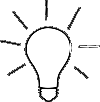 LET’S MAKE THIS AN EXPLORATION of the landscapes of creativity — how does the creative experience feel to you?
LET’S MAKE THIS AN EXPLORATION of the landscapes of creativity — how does the creative experience feel to you?
Mentally, I’m all about visualization: perhaps it’s synesthesia, but even smells and sounds have a visual component for me. So I’ve always seen “the creative process” as starting with a curtain across half the universe. Every now and then, the curtain parts just enough to reveal an Idea.
It could be a series of images, even images of words. Now and then it’s a sound. But even the most abstract Idea carries a visual impression of girders and joists, ropes and scrim. Sometimes an Idea will be revealed a piece at a time, with a whole clicking into place almost audibly and palpably. If it’s long, like a story, it feels like a rope uncoiling from the other side of the curtain — a line which must not be allowed to grow slack.
Sometimes an Idea links up with something inside the rest of the universe. Other times it just sits there, gleaming, faintly pulsing, daring me to capture it in words on a screen or a sketch in a notebook. (If I don’t, it can fade within minutes.)
So let’s make this an exploration of the sense-scapes of creativity. How does the creative experience feel to you?


